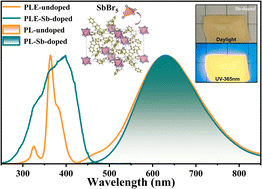Boosting the broadband orange emission in organic–inorganic hybrid (DPG)3InBr6via antimony doping†
Abstract
Organic–inorganic hybrid metal halides are considered potential candidates for solid-state lighting (SSL) and display technology due to their unique photophysical properties, facile synthesis and low costs. Among them, In(III)-based metal halides stand out due to their broadband emission, low-toxicity, and remarkable stability. Herein, we developed a new lead-free metal halide of (DPG)3InBr6 (DPG = 1,3-diphenylguanidine), in which the isolated [InBr6]3− octahedrons are surrounded by an organic ligand with a photoluminescence quantum yield (PLQY) of 30.4%. To enhance this, Sb-doped (DPG)3InBr6 is prepared, which induces extra excitons, and produces broad band emission with a PLQY of 99.2% and a full width at half maximum (FWHM) of 166 nm with a large Stokes shift of 232 nm. This broad emission band is derived from the triplet self-trapped excitons (STEs) out of the Pyramid SbBr5 and octahedral InBr6 with high Huang–Rhys factor (45.5). Together with highly efficient broadband emission and remarkable stability of Sb-doped (DPG)3InBr6, a high-performance white-light emitting diode (WLED) with a high color-rendering index (CRI) of 86.9 and a luminous efficacy of 30.9 lm W−1 is demonstrated, indicating its potential application in photonic devices.



 Please wait while we load your content...
Please wait while we load your content...